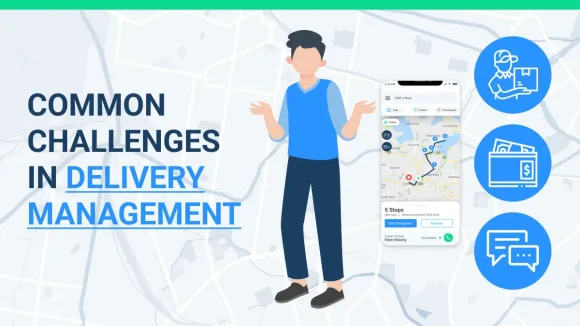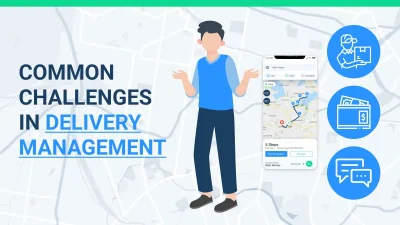Overcoming common challenges in delivery management is not an easy task. From inefficient planning, inaccurate delivery times and inadequate resources, there are several steps to making the delivery process more seamless and better for drivers and customers.
Before getting into the solutions, let’s have a look at the challenges in delivery management that most businesses face.

Last mile delivery challenges
Inefficient planning
Delivery management has a lot of difficulties due to ineffective planning. It may happen for a number of causes, such as limited resources, erroneous delivery times, and a lack of visibility into delivery timetables.
For instance, it can be difficult to optimize delivery routes and assign drivers to the most effective routes without sufficient visibility into delivery timetables. Deliveries may be delayed and less productive as a result of drivers having to travel further or make unneeded stops. This also makes same day delivery an absolute nightmare!
Inaccurate delivery times
Delivery management can also be complicated by inaccurate delivery times. Inaccurate delivery estimates may result in missed or delayed deliveries when consumers expect a timely delivery, which may have a negative effect on customer satisfaction. Furthermore, it can be challenging to organize delivery schedules and assign drivers to the most effective routes when delivery timings are erroneous.
Inadequate resources
Planning can become ineffective if there are not enough delivery personnel, vehicles, or storage facilities. Without sufficient resources, companies would find it difficult to meet consumer demand, which could result in lost or delayed deliveries. The quality of deliveries can also be affected by insufficient resources, since some orders may arrive spoiled or damaged.

How to solve common challenges in delivery management
Utilize delivery management software
Businesses can use delivery management software to streamline delivery schedules, allocate drivers to the most effective routes, and provide real-time delivery status insight. With the use of this software, companies can provide customers with precise delivery time estimates as well as alert them to any delays or changes in delivery plans.
Invest in resources
Companies can make the necessary investments in delivery personnel, vehicles, and storage facilities to support their delivery operations. With appropriate resources, organizations can satisfy client demand and increase the quality of deliveries.
Implement preventative maintenance
Preventative maintenance can reduce the likelihood of vehicle failure and guarantee that delivery drivers have dependable, well-maintained vehicles. This could lessen delays and increase delivery process effectiveness.
Plan for unforeseen circumstances
By including time buffers in their delivery plans, companies can prepare for unforeseen events like traffic and bad weather. This can ensure that delivery drivers, regardless of the weather, have ample time to complete their deliveries.
Improve communication
Having open lines of communication between delivery drivers and dispatchers can increase coordination and lessen communication issues. For customer communication, multilingual help can also be offered to guarantee that client expectations are satisfied.

How do I choose a delivery management software?
Identify your requirements
Identify the requirements for a delivery management software. The size of your delivery operations, the number of drivers, and the types of deliveries you make are just a few things to take into account.
Do your research
Look into the many delivery management software options on the market. To decide which program best meets your needs, compare features, costs, and user reviews.
Check capabilities
To ensure compatibility with your current systems, such as your fleet management program, warehouse management system, or e-commerce platform, check to determine if the delivery management system is compatible. As a result, there will be less opportunities for errors, and integration will go without issue.
Evaluate user-friendliness
Think about how user-friendly the delivery management software is. Make sure your team can easily learn how to use it and that it has a user-friendly interface.
Check for real-time tracking
Check the software for delivery management’s real-time tracking capabilities. With the use of this feature, you may tell customers about any alterations to delivery times and provide real-time delivery tracking information.
Ensure customer communication
Check if the delivery management software has a customer communication feature. This feature will enable you to communicate with customers regarding their orders and delivery schedules.
Check for automation
Check to discover if the delivery management software automates the dispatching, route-optimization, and driver-allocation processes. Automation can help delivery times and reduce errors, as well as ensure a successful delivery for each booking.
Consider security
Ensure the delivery management software has appropriate security components, such as user authentication and data encryption. This will safeguard your data from online dangers.

Overcome challenges in delivery management with Locate2u
Locate2u is an all-in-one software solution that can help transform your delivery service and combat challenges faced in last mile delivery management.
Locate2u automates your entire delivery process from start to finish and builds the most efficient routes so your drivers can carry out more bookings.
Click here to learn more about how Locate2u can assist your last mile delivery process in meeting customer expectations and completing same day deliveries.
About the author
Marketing Coordinator at Locate2u having completed a Bachelor of Creative Arts, majoring in English Literature and Creative Writing. I have extensive experience in editing and proofreading, as well as creating content for a range of audiences.











